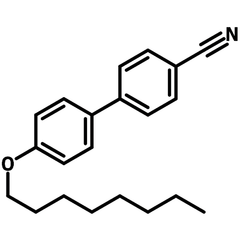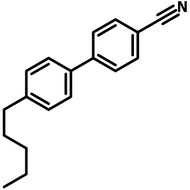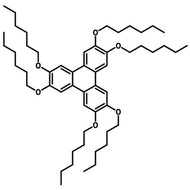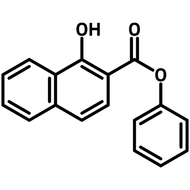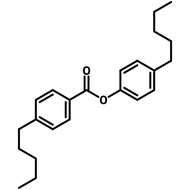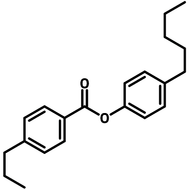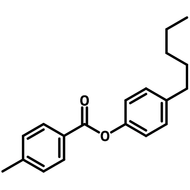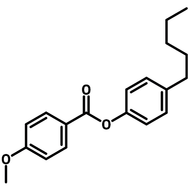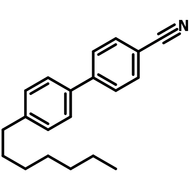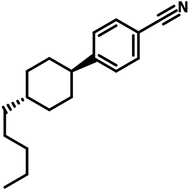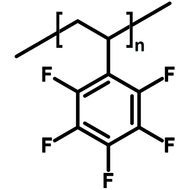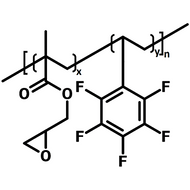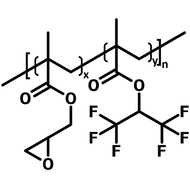4′-Octyloxy-4-biphenylcarbonitrile (8OCB), liquid crystal
Nematic/smectic A liquid crystal for the application of optical electronics i.e. in liquid-crystal display (LCD).
4′-Octyloxy-4-biphenylcarbonitrile (8OCB), CAS number 52364-73-5, is consisted of a biphenyl structure with octyloxy and cyano groups at 4,4'-postions. 8OCB belongs to the well known family of liquid crystal 4-oxy-4'-cyanobiphenyls (OCBs). In its solid form, 8OCB packs in lamellar-type bilayers structure, through hydrogen bonding induced by the CN group.
Three different metastable crystal polymorphs of 8OCB are observed from grown from its solution, square-plate, needle phase and long parallelepiped (PP) phase. Two different crystalline states of 8OCB are observed on cooling from its melt, a metastable long parallelepiped (PP) crystal phase and a stable crystal phase known as the commercial powder (CP) phase. Three transition temperatures temperature are measured for 8OCB from its crystal from to isotropic solution, crystalline–smectic A transition temperature, TCrA = 52.86 °C, smectic A–nematic transition temperature, TAN = 66.65 °C, and nematic–isotropic transition temperature, TNI = 79.10 °C.
Binary system of 4-octyl-4′-cyanobiphenyl (8CB) and 4-octyloxy-4′-cyanobiphenyl (8OCB) mixture also shows the existence of three phase transitions, crystalline-smectic A, smectic A-nematic, and nematic-isotropic transitions. The maximum absorption wavelength of the 8CB/8OCB mixtures decreases with increasing percent weight of 8CB in 8OCB.
When presented in P3HT:PC60BM mixture, 4′-octyloxy-4-biphenylcarbonitrile molecules in the liquid crystalline state offer good template for the crystallization of P3HT, as well as the phase separation between P3HT and PCBM. A maximum PCE value of 3.5% was achieved by incorporating of 6 wt% nematic liquid crystals (NLCs) of 8OCB in P3HT:PC60BM active layer mixture, after annealing at the temperature of 70 °C in liquid crystalline transitions.
Liquid crystal
With biphenylcarbonitrile core
Three phase transition
Crystalline - smectic A - nematic - isotropic
Worldwide shipping
Quick and reliable shipping
High purity
>98% High purity
Chemical Structure

General Information
| CAS Number | 52364-73-5 |
| Chemical Formula | C21H25NO |
| Molecular Weight | 307.43 |
| Full Name | 4′-Octyloxy-4-biphenylcarbonitrile |
| Synonyms | 8OCB, 4′-(Octyloxy)-4-cyanobiphenyl, 4′-(Octyloxy)[1,1′-biphenyl]-4-carbonitrile, 4'-Octyloxybiphenyl-4-carbonitrile, 4-Cyano-4′-(octyloxy)biphenyl, 4-n-octyloxy-4′-cyanobiphenyl, 4-Cyano-4'-n-octyloxybiphenyl |
| Classification / Family | Biphenylcarbonitrile, Liquid Crystals |
Product Details
| Purity | >98% (1HNMR) |
| Form | White powder/crystals |
| Mesomorphic Range | N/A |
| Melting Point | Tm = 54 °C |
MSDS Documentation
 4′-Octyloxy-4-biphenylcarbonitrile MSDS Sheet
4′-Octyloxy-4-biphenylcarbonitrile MSDS Sheet
Pricing
| Batch | Quantity | Price |
| M2360A1 | 5 g | £170 |
| M2360A1 | 10 g | £250 |
| M2360A1 | 25 g | £500 |
Literature and Reviews
- 4'-Octyloxybiphenyl-4-carbonitrile polymorph III, R. Davey et al., Acta Cryst., C61, o143-o144 (2005); DOI: 10.1107/S0108270105000326.
- Polymorphic crystalline forms of 8OCB, A. Jakli et al., Liq. Cryst., 27 (8), 1035-1038 (2000); DOI: 10.1080/02678290050080779.
- DSC studies on p-(n-alkyl)-p′-cyanobiphenyl (RCB’s) and p-(n-alkoxy)-p′-cyanobiphenyl (ROCB’s) liquid crystals, G. Oweimreen et al., Thermochimica Acta, 346, 37 (2000); DOI: 10.1016/S0040-6031(99)00411-6.
- Crystal polymorphism of 8OCB liquid crystal consisting of strongly polar rod-like molecules, S. Ghosh et al., RSC Adv., 11, 4958 (2021); DOI: 10.1039/d0ra08543j.
- Thermal and Spectrophotometric Analysis of Liquid Crystal 8CB/8OCB Mixtures, Ş. Özgan et al., Braz. J. Phys., 41, 118–122 (2011); DOI: 10.1007/s13538-011-0034-1.
- Improvement of the photovoltaic properties for P3HT:PCBM system annealed at the temperature in liquid crystalline regions induced by liquid crystal molecules, J. Shi et al., Polym. Bull. 71, 2963–2979 (2014); DOI: 10.1007/s00289-014-1233-z.
